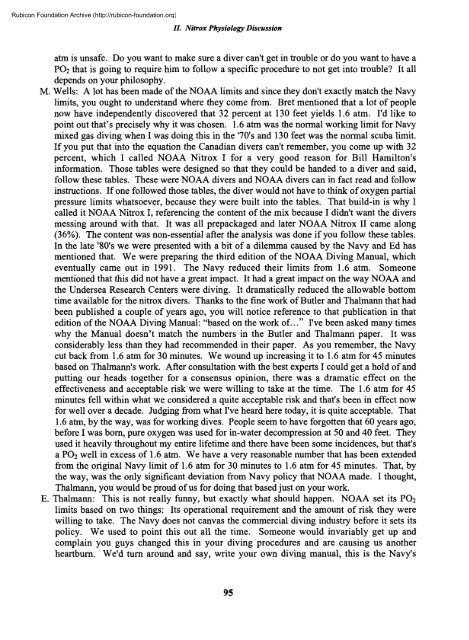Nitrox workshop dings - Divers Alert Network
Nitrox workshop dings - Divers Alert Network
Nitrox workshop dings - Divers Alert Network
You also want an ePaper? Increase the reach of your titles
YUMPU automatically turns print PDFs into web optimized ePapers that Google loves.
Rubicon Foundation Archive (http://rubicon-foundation.org)//. <strong>Nitrox</strong> Physiology Discussionatm is unsafe. Do you want to make sure a diver can't get in trouble or do you want to have aPO2 that is going to require him to follow a specific procedure to not get into trouble? It alldepends on your philosophy.M. Wells: A lot has been made of the NOAA limits and since they don't exactly match the Navylimits, you ought to understand where they come from. Bret mentioned that a lot of peoplenow have independently discovered that 32 percent at 130 feet yields 1.6 atm. I'd like topoint out that's precisely why it was chosen. 1.6 atm was the normal working limit for Navymixed gas diving when I was doing this in the 7O's and 130 feet was the normal scuba limit.If you put that into the equation the Canadian divers can't remember, you come up with 32percent, which I called NOAA <strong>Nitrox</strong> I for a very good reason for Bill Hamilton'sinformation. Those tables were designed so that they could be handed to a diver and said,follow these tables. These were NOAA divers and NOAA divers can in fact read and followinstructions. If one followed those tables, the diver would not have to think of oxygen partialpressure limits whatsoever, because they were built into the tables. That build-in is why Icalled it NOAA <strong>Nitrox</strong> I, referencing the content of the mix because I didn't want the diversmessing around with that. It was all prepackaged and later NOAA <strong>Nitrox</strong> II came along(36%). The content was non-essential after the analysis was done if you follow these tables.In the late '80's we were presented with a bit of a dilemma caused by the Navy and Ed hasmentioned that. We were preparing the third edition of the NOAA Diving Manual, whicheventually came out in 1991. The Navy reduced their limits from 1.6 atm. Someonementioned that this did not have a great impact. It had a great impact on the way NOAA andthe Undersea Research Centers were diving. It dramatically reduced the allowable bottomtime available for the nitrox divers. Thanks to the fine work of Butler and Thalmann that hadbeen published a couple of years ago, you will notice reference to that publication in thatedition of the NOAA Diving Manual: "based on the work of..." I've been asked many timeswhy the Manual doesn't match the numbers in the Butler and Thalmann paper. It wasconsiderably less than they had recommended in their paper. As you remember, the Navycut back from 1.6 atm for 30 minutes. We wound up increasing it to 1.6 atm for 45 minutesbased on Thalmann's work. After consultation with the best experts I could get a hold of andputting our heads together for a consensus opinion, there was a dramatic effect on theeffectiveness and acceptable risk we were willing to take at the time. The 1.6 atm for 45minutes fell within what we considered a quite acceptable risk and that's been in effect nowfor well over a decade. Judging from what I've heard here today, it is quite acceptable. That1.6 atm, by the way, was for working dives. People seem to have forgotten that 60 years ago,before I was born, pure oxygen was used for in-water decompression at 50 and 40 feet. Theyused it heavily throughout my entire lifetime and there have been some incidences, but that'sa PO2 well in excess of 1.6 atm. We have a very reasonable number that has been extendedfrom the original Navy limit of 1.6 atm for 30 minutes to 1.6 atm for 45 minutes. That, bythe way, was the only significant deviation from Navy policy that NOAA made. I thought,Thalmann, you would be proud of us for doing that based just on your work.E. Thalmann: This is not really funny, but exactly what should happen. NOAA set its PO2limits based on two things: Its operational requirement and the amount of risk they werewilling to take. The Navy does not canvas the commercial diving industry before it sets itspolicy. We used to point this out all the time. Someone would invariably get up andcomplain you guys changed this in your diving procedures and are causing us anotherheartburn. We'd turn around and say, write your own diving manual, this is the Navy's95
















